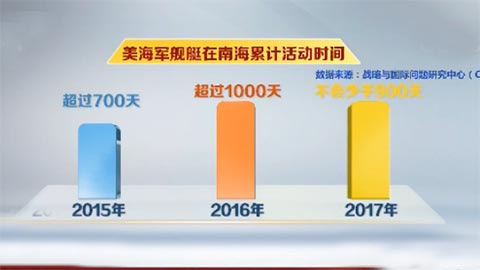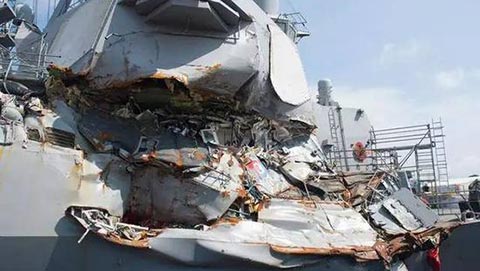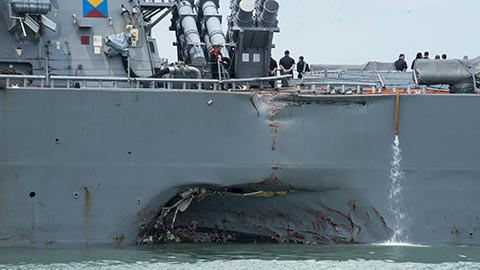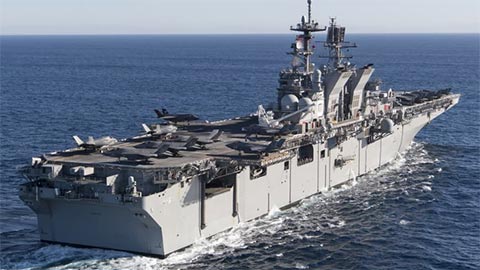The US military suspended its global operations for two years, and the cumulative duration of its activities in the South China Sea exceeded 1,000 days.
CCTV News:Take the South China Sea as an example — — According to data from CSIS, the Center for Strategic and International Studies, in 2015, the total time of US naval vessels’ activities in the South China Sea exceeded 700 days; In 2016, this number exceeded 1000 days; After Trump took office, the outside world once thought that the activities of the US military in the South China Sea might turn to a low profile: however, Pacific Fleet Commander Swift confirmed earlier that in 2017, the total time of the US Navy’s activities in the South China Sea will not be less than 900 days.

According to a report by the US Government Accountability Office, destroyers and cruisers deployed in the United States only leave Hong Kong for an average of 41% of the time, but ships deployed in Japan spend as much as 67% of the time on missions.
It is worth noting that on the 21st, US Naval Operations Secretary Richardson ordered a comprehensive inspection of the Seventh Fleet in Japan, while calling for a suspension of global operations. — The content of the inspection includes "action intensity".

The destroyer Fitzgerald was badly damaged.
From the cruiser Antietam, which hit the rocks in Tokyo Bay in January this year, to the cruiser Chamberlain Lake, which hit a fishing boat in the eastern waters of the Korean Peninsula in May, and then to the merchant ships Fitzgerald and McCain in June and August — — Has a series of accidents caused systemic risks to the strategy of returning to the Asia-Pacific region?
US Naval Operations Secretary: Temporarily suspend naval operations around the world.
Dozens of hours have passed since the collision of the American warship "McCain", and the truth of the accident is still unknown. However, the US Navy suddenly announced and suspended its operations on a global scale late at night on the 21st, which was described by experts as "extremely rare".

The warship "McCain" collided with the ship.
On August 21, before many Americans started their new week’s work, they were first told that another American warship had an accident!
The overwhelming reports of various media in the United States are also a huge pressure of public opinion — — At about 23 o’clock in the middle of the night on the 21st, Beijing time, the top military attache of the US Navy personally came forward and released a heavy news: Richardson did not give a time limit for suspending global operations in this statement, but according to reports from the US media, the suspension may last for 1-2 days.
According to the latest data from the official website of the US Navy, as of August 21st, the total number of US Navy in active service was 322,421, with 277 ships and more than 3,700 aircraft.
The strongest amphibious ship in the United States arrived in Singapore and was the first to dispatch a plane to participate in search and rescue.

pcu america lha 6

Osprey tilt-rotor aircraft
At around 15 pm local time on the 21st, the badly damaged "McCain" slowly entered Singapore Changi Naval Base. But little known is that about four hours later, amphibious assault ship’s "America", the newest and most powerful US military in active service, quietly entered the same base — — In fact, the first person to search and rescue the missing persons was the Osprey tilt-rotor aircraft that took off from the American. This quasi-aircraft carrier, which only served in 2014, has its home port in San Diego on the west coast of the United States. Why did it appear in the South China Sea?
It turns out that due to the influence of logistics maintenance and other factors, the US military can no longer guarantee that there are aircraft carrier activities in the western Pacific at any time, and can only dispatch quasi-aircraft carriers such as large amphibious ships from the mainland to make up for the vacancy of aircraft carriers — — This phenomenon itself is the embodiment of the high-intensity actions of the US military in the Asia-Pacific region, especially in the western Pacific region.